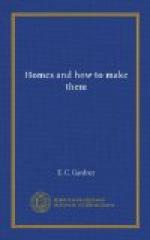From the Architect.
The beauty of truth and utility.
Dear John: I am glad my efforts in your behalf are likely to be appreciated, especially if you share this common opinion of architects, that their mission is accomplished when they have made a pretty picture, and that they are an expensive luxury, which the man who would build himself a house must forego if he would be able to finish. Greater durability, comfort, and convenience are not expected on account of their assistance, only that the house shall be more surprisingly beautiful. Doubtless there is some ground for this poor opinion, but the architects are not alone in their folly, or wholly responsible; they attempt to supply an unreasonable demand, and are driven to employ unworthy means.
The first grand lesson for you to learn (you must have patience with a little more “preachment”) is that the beauty of your building cannot be thrust upon it, but must be born with it, must be an inseparable part of it, the result and evidence of its real worth. We must forget our great anxiety as to how our houses shall be clothed, aiming first to make them strong and durable, comfortable and convenient, being morally certain that they will not then be disagreeable to look upon. Professing a great contempt for a man who tries to seem something better and wiser than he is, let us be equally severe in condemning every building that puts on airs and boldly bids us admire what is only fit to be despised. The pendulum seems to have swung away from the plain, utilitarian mode of building that was forced upon our ancestors by a stern necessity,—possibly chosen from a sense of duty,—to the other extreme; giving us, instead of the old-time simplicity, many a fantastic design that claims admiration for its originality or its modern style. The notion that there can be a mere architectural fashion, having any rights that intelligent people are bound to respect, is quite absurd. Improved modes of construction and new helps to comfort and convenience are constantly invented, but one might as well talk of the latest fashions for the lilies of the fields or the stars in the heavens, as of a fashionable style in architecture or any other enduring work of art. Whatever building is nobly and enduringly useful, thoroughly adapted to its uses, cannot be uncomely. Its outward beauty may be increased by well-contrived disposition of materials, or even added details not strictly essential to its structure; but, if rightly built, it will not be ugly without these additions, and beware of using them carelessly. What might have been a very gem of homely and picturesque grace, if left in modest plainness, may be so overburdened with worthless trash that its original expression is lost and its simple beauty becomes obtrusive deformity. Even conspicuous cheapness is not necessarily unpleasant to see, but don’t try to conceal it by forcing the materials to seem something better than they are. Let wood stand for wood, brick for brick, and never ask us to imagine a brown-stone value to painted sheet-iron. There is, too, a deeper honesty than mere truth-telling in material; a conscientiousness of purpose, an artistic spiritual sense of the eternal fitness, without which there can be no worthy achievement, no lasting beauty.




